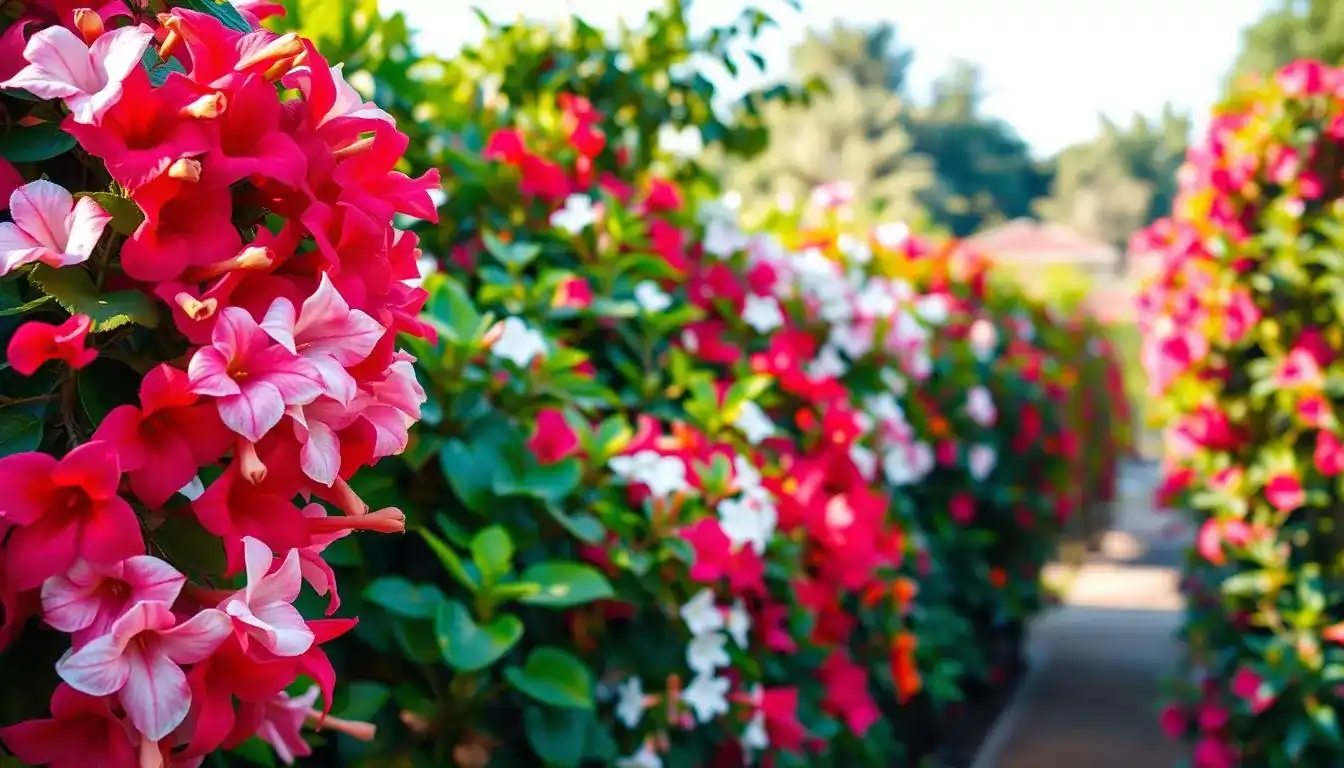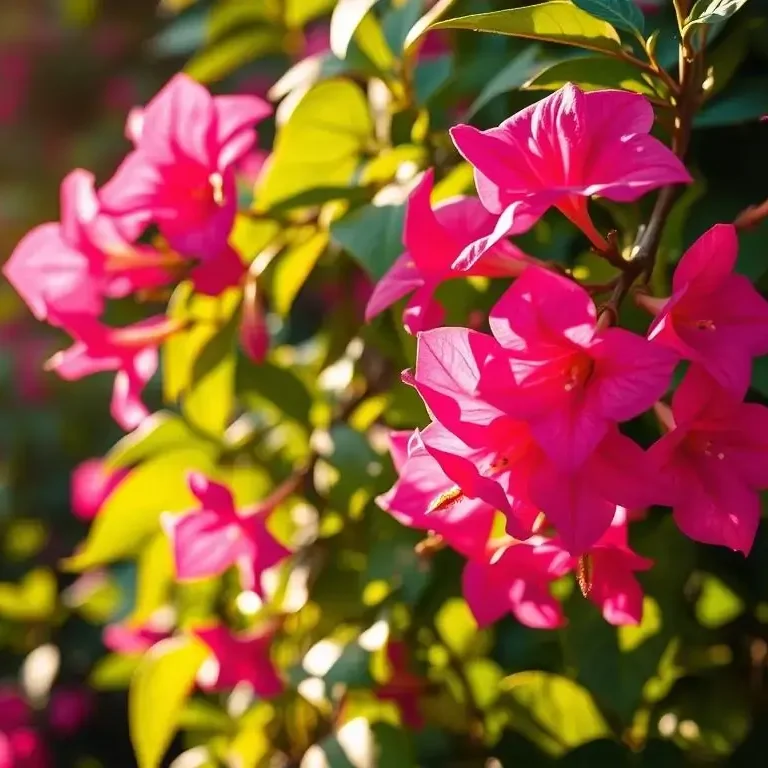To keep your mandevilla plant thriving, understanding its basic needs is crucial. Proper care includes providing the right amount of sunlight, water, and fertilizer. Mandevilla plants are known for their vibrant blooms and can add a tropical touch to your garden or indoor space. By learning how to grow mandevilla effectively, you can enjoy its beautiful flowers throughout the growing season. This involves understanding the specific requirements for sunlight, watering, and fertilization that cater to the plant’s health and blooming potential.
Key Takeaways
- Understand the sunlight needs of your mandevilla plant.
- Learn the appropriate watering schedule.
- Fertilization tips for optimal blooming.
- Tips for maintaining overall plant health.
- Common mistakes to avoid in mandevilla care.
All About Mandevilla Plants
Mandevilla, a flowering vine native to the tropical regions of South America, is prized for its large, showy flowers and versatility in landscaping. These plants have gained popularity worldwide for their ability to thrive in various environments, from indoor containers to outdoor gardens.
Origin and Characteristics
Mandevilla plants are characterized by their vigorous growth, large, dark green leaves, and vibrant, trumpet-shaped flowers. They are evergreen climbers that can grow quite long, making them ideal for trellises or hanging baskets. Native to the tropical climates, they thrive in warm temperatures and high humidity.
Popular Varieties and Colors
Mandevilla plants come in several varieties, with flowers ranging in color from pure white to deep pink and red. Some popular varieties include Mandevilla sanderi and Mandevilla x amabilis. The table below summarizes some of the most common varieties and their characteristics:
| Variety | Flower Color | Growth Habit |
| Mandevilla sanderi | Pink | Climbing |
| Mandevilla x amabilis | White/Pink | Vigorous Climber |
| Mandevilla boliviensis | White | Compact |

Ideal Growing Conditions for Mandevilla
Understanding the ideal growing conditions for mandevilla is crucial for gardeners looking to cultivate these beautiful vines. To create an optimal environment, you need to consider several key factors.
Climate and Hardiness Zones
Mandevilla plants thrive in warm, humid climates, typically found in USDA Hardiness Zones 9-11. If you live in a cooler climate, you can still grow mandevilla in containers that can be moved indoors during the winter months.
Temperature Requirements: Mandevilla prefers temperatures between 65°F and 90°F (18°C and 32°C). Temperatures below 50°F (10°C) can cause damage to the plant.
Indoor vs. Outdoor Growing
You can grow mandevilla both indoors and outdoors, provided you meet its basic needs. Outdoor growing is ideal in warm climates where the plant can receive full sun to partial shade. Indoors, it requires bright, indirect light.
Container Selection and Soil Requirements
Choosing the right container and soil is vital for healthy mandevilla growth. Use a well-draining potting mix and a container that is at least 6-8 inches deep to accommodate the root system.
| Container Size | Soil Type | Drainage Requirements |
| At least 6-8 inches deep | Well-draining potting mix | Presence of drainage holes |
By considering these factors, you can create an ideal environment for your mandevilla to thrive.
Mandevilla Sunlight Requirements
To ensure your mandevilla plant flourishes, it’s essential to understand its sunlight requirements. Mandevilla plants are known for their vibrant flowers and vigorous growth, but these characteristics are heavily influenced by the amount of sunlight they receive.
Optimal Sun Exposure
Mandevilla plants generally require full sun to partial shade. Optimal sun exposure for these plants is typically considered to be at least 6 hours of direct sunlight per day. However, in warmer climates, some afternoon shade can be beneficial to prevent scorching of the leaves.
Seasonal Light Adjustments
As the seasons change, so do the sunlight patterns. During the summer months, mandevilla plants can usually tolerate full sun, but in the winter, they may require protection from colder, less intense sunlight. Adjusting the plant’s position seasonally can help ensure it receives the right amount of light.
Protecting from Intense Heat
In regions with very hot summers, it’s crucial to protect your mandevilla from intense heat. Providing some afternoon shade or using a sheer curtain to filter the sunlight can help prevent damage to the plant’s leaves and flowers.
| Sunlight Condition | Mandevilla Response | Care Adjustment |
| Full Sun | Vigorous growth and abundant flowering | Ensure adequate watering |
| Partial Shade | Less vigorous, fewer flowers | Adjust fertilization accordingly |
| Intense Heat | Risk of leaf scorch and stress | Provide afternoon shade or shading |
Watering Your Mandevilla Properly
Mandevilla plants require careful watering to thrive, making it essential to understand their needs. Proper watering techniques are vital for maintaining the health and promoting the blooming of these beautiful plants.
Watering Frequency and Technique
The frequency of watering your mandevilla depends on several factors, including the climate, soil mix, and pot size. Generally, you should water your mandevilla when the top inch of soil feels dry to the touch. Water thoroughly until you see water draining out of the pot’s bottom holes, indicating that the soil is fully saturated. This helps prevent waterlogged soil and root rot.
In warmer climates or during the active growing season, mandevilla plants may require more frequent watering. Conversely, during cooler months or in humid environments, less frequent watering may be necessary.
Signs of Overwatering and Underwatering
It’s crucial to recognize the signs of both overwatering and underwatering. Overwatering can lead to root rot, characterized by yellowing leaves and a soft, mushy stem. On the other hand, underwatering can cause leaf wilt and a decrease in blooming. Adjust your watering schedule based on these observations to keep your mandevilla healthy.
Humidity Considerations
Mandevilla plants prefer a humid environment, typically above 50% relative humidity.
“To maintain the right humidity, you can place the pot on a tray filled with water and pebbles or use a humidifier nearby.”
This is particularly important in dry climates or during the winter months when indoor heating can dry out the air.
Fertilizing and Feeding Mandevilla
Mandevilla plants require careful fertilization to achieve optimal blooming and health. Fertilization plays a critical role in promoting the vigorous growth and flowering that these plants are known for.
Best Fertilizers for Optimal Blooming
For optimal blooming, mandevilla plants benefit from fertilizers that are high in phosphorus. A balanced fertilizer with an N-P-K ratio of 15-30-15 or 20-20-20 is recommended. You can also consider using a bloom booster that is specifically formulated to enhance flowering.
- Use a fertilizer that is formulated for flowering plants.
- Look for products with micronutrients like magnesium and iron.
- Avoid fertilizers with high nitrogen levels as they can promote leaf growth at the expense of blooms.
Fertilizing Schedule and Application Methods
Fertilize your mandevilla plant every two weeks during the growing season, which typically spans from spring to early fall. Use a water-soluble fertilizer to ensure easy absorption. Always follow the manufacturer’s instructions for the correct dosage to avoid over-fertilizing.
Common Nutrient Deficiencies and Solutions
Mandevilla plants can suffer from nutrient deficiencies, which may manifest as yellowing leaves or poor blooming. Common deficiencies include lack of nitrogen, iron, and magnesium. To address these issues, you can use specific fertilizers or foliar sprays that contain the necessary nutrients.
- For nitrogen deficiency, use a balanced fertilizer.
- For iron deficiency, apply an iron chelate product.
- For magnesium deficiency, use Epsom salt or a magnesium-rich fertilizer.
Maintenance and Troubleshooting

Regular maintenance is key to unlocking your mandevilla plant’s full potential and preventing common issues. To keep your mandevilla thriving, it’s essential to understand the necessary care techniques.
Pruning and Training Techniques
Pruning mandevilla is crucial for maintaining its shape and promoting healthy growth. Prune your mandevilla in the spring, removing any dead or damaged stems. This will encourage new growth and help control the plant’s size.
Training your mandevilla vine involves gently twining it around a trellis or other support. This not only adds visual appeal but also helps to keep the plant organized and promote better blooming.
Propagation Methods
Learning how to grow mandevilla from cuttings can be a rewarding experience. To propagate, take 4-6 inch stem cuttings from the tip of a healthy stem, remove lower leaves, and plant them in moist soil. Keep the soil warm and humid until roots develop.
Common Pests and Diseases
Regularly inspect your mandevilla for signs of pests or diseases. Common issues include mealybugs, spider mites, and root rot. Use insecticidal soap or fungicides as needed, and ensure good air circulation around your plants to prevent fungal diseases.
Overwintering Strategies
In colder climates, mandevilla care involves protecting the plant from frost. Bring container-grown mandevillas indoors before the first frost, or mulch heavily around the base if the plant is in the ground. Reduce watering during the winter months, as the plant is dormant.
By following these maintenance and troubleshooting tips, you can enjoy your mandevilla plant’s beautiful blooms for years to come.
Conclusion
By understanding and meeting the sun, water, and fertilizer needs of your mandevilla plant, you can enjoy its vibrant blooms throughout the growing season. Proper mandevilla care involves providing the right conditions, including optimal sunlight exposure, watering frequency, and fertilization schedule.
To keep your mandevilla thriving, remember to adjust its care according to the season. Protect it from intense heat, and maintain a suitable humidity level. Regular pruning and training will also help control its growth and promote blooming.
With the knowledge gained from this article, you’re now equipped to provide your mandevilla plant with the care it needs to flourish. By following these guidelines, you can enjoy a beautiful, flowering mandevilla plant that adds beauty and vibrancy to your outdoor or indoor space.

